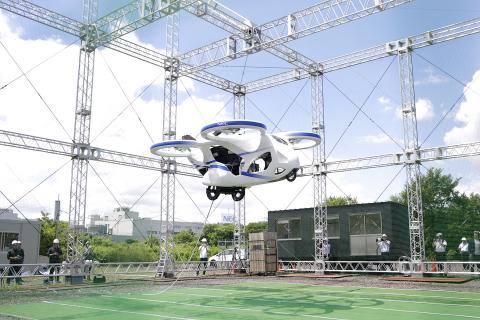Japanese electronics maker NEC Corp yesterday showed a “flying car,” a large drone-like machine with four propellers that hovered steadily for about a minute.
The test flight reaching 3m high was held in a gigantic cage, as a safety precaution, at an NEC facility in a Tokyo suburb.
The preparations such as the repeated checks on the machine and warnings to reporters to wear helmets took up more time than the two brief demonstrations.

Photo: Bloomberg
The Japanese government is behind flying cars, with the goal of having people zipping around in them by the 2030s.
Among the government-backed endeavors is a huge test course for flying cars that it has built in an area devastated by the 2011 tsunami, quake and nuclear disasters in Fukushima in northeastern Japan.
Mie Prefecture in central Japan, which is frequently used as a resort area by Hollywood celebrities, also hopes to use flying cars to connect its various islands.
Similar projects are popping up around world, such as Uber Air of the US.
A flying car by Japanese start-up Cartivator crashed quickly in a 2017 demonstration.
Cartivator chief executive Tomohiro Fukuzawa, who was at yesterday’s demonstration, said their machines were also flying longer lately.
NEC is among the more than 80 sponsor companies for Cartivator’s flying car, which also include Toyota Motor Corp group companies and video game company Bandai Namco Holdings.
The goal is to deliver a seamless transition from driving to flight like the world of Back to the Future, although huge hurdles remain such as battery life, the need for regulations and safety concerns.
NEC officials said their flying car was designed for unmanned flights for deliveries, but utilized the company’s technology in its other operations such as space travel and cybersecurity.
Often called EVtol, for “electric vertical takeoff and landing” aircraft, a flying car is defined as an aircraft that is electric, or hybrid electric, with driverless capabilities, that can land and takeoff vertically.
All of the flying car concepts, which are like drones big enough to hold humans, promise to be better than helicopters.
Helicopters are expensive to maintain, noisy to fly and require trained pilots. Flying cars also are being touted as useful for disaster relief.
Uber is planning demonstrator flights next year and commercial operations in 2023, and has chosen Dallas, Los Angeles and Melbourne as the first cities to offer what it calls Uber Air flights.
Dubai has also been aggressive about pursuing flying cars.
Japanese officials say Japan has a good chance of emerging as a world leader because the government and the private sector will work closely together.

DIVIDED VIEWS: Although the Fed agreed on holding rates steady, some officials see no rate cuts for this year, while 10 policymakers foresee two or more cuts There are a lot of unknowns about the outlook for the economy and interest rates, but US Federal Reserve Chair Jerome Powell signaled at least one thing seems certain: Higher prices are coming. Fed policymakers voted unanimously to hold interest rates steady at a range of 4.25 percent to 4.50 percent for a fourth straight meeting on Wednesday, as they await clarity on whether tariffs would leave a one-time or more lasting mark on inflation. Powell said it is still unclear how much of the bill would fall on the shoulders of consumers, but he expects to learn more about tariffs

NOT JUSTIFIED: The bank’s governor said there would only be a rate cut if inflation falls below 1.5% and economic conditions deteriorate, which have not been detected The central bank yesterday kept its key interest rates unchanged for a fifth consecutive quarter, aligning with market expectations, while slightly lowering its inflation outlook amid signs of cooling price pressures. The move came after the US Federal Reserve held rates steady overnight, despite pressure from US President Donald Trump to cut borrowing costs. Central bank board members unanimously voted to maintain the discount rate at 2 percent, the secured loan rate at 2.375 percent and the overnight lending rate at 4.25 percent. “We consider the policy decision appropriate, although it suggests tightening leaning after factoring in slackening inflation and stable GDP growth,”

Greek tourism student Katerina quit within a month of starting work at a five-star hotel in Halkidiki, one of the country’s top destinations, because she said conditions were so dire. Beyond the bad pay, the 22-year-old said that her working and living conditions were “miserable and unacceptable.” Millions holiday in Greece every year, but its vital tourism industry is finding it harder and harder to recruit Greeks to look after them. “I was asked to work in any department of the hotel where there was a need, from service to cleaning,” said Katerina, a tourism and marketing student, who would

i Gasoline and diesel prices at fuel stations are this week to rise NT$0.1 per liter, as tensions in the Middle East pushed crude oil prices higher last week, CPC Corp, Taiwan (台灣中油) and Formosa Petrochemical Corp (台塑石化) said yesterday. International crude oil prices last week rose for the third consecutive week due to an escalating conflict between Israel and Iran, as the market is concerned that the situation in the Middle East might affect crude oil supply, CPC and Formosa said in separate statements. Front-month Brent crude oil futures — the international oil benchmark — rose 3.75 percent to settle at US$77.01